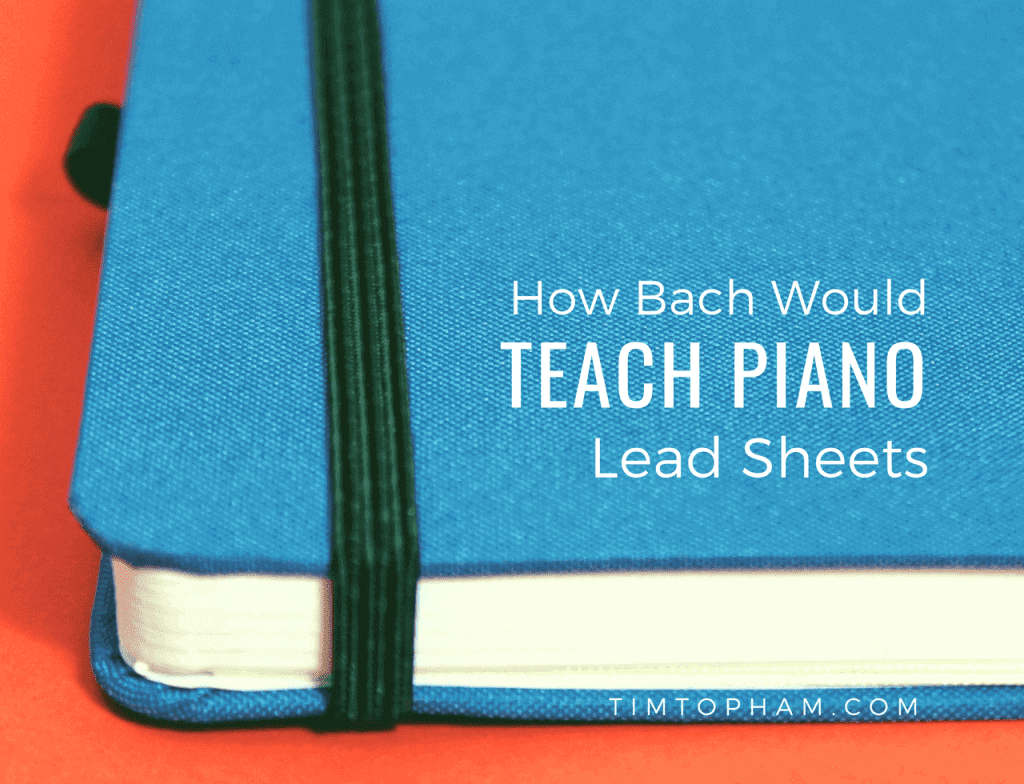Harmony forms the base of composing and improvising.

Most piano instruction since the 19th century has been focused on having students play notes from scores and try to become solo performers. As a result, playing by chord symbols is now usually viewed as something secondary. But this is not how it once was!
So, I’d like to start by giving you a quick sense of the history of a chord-based approach and how essential it is for musicians.
Tim also wrote recently on the power of a chordal-based playing in his blog: 9 Reasons why Playing Lead Sheets is Essential for Piano Students.
I consider J.S. Bach to be the grand patriarch of our modern Western tradition. According to Bach’s son Carl, the first thing that Bach taught his students was harmony because that is the foundation for understanding how to improvise, arrange, and compose music.
Musicians in Bach’s time were viewed as craftspeople able to craft music for any occasion. They were not seen as stage performers. These musicians could improvise, arrange, and compose music. That’s what musicians did in the days before printed music became widely available.
Bach and his father and his father were what I call community musicians, people who crafted music for weddings, and church services, and such. So this is how Bach trained his students. They could accompany singers and other instrumentalists, and change keys quickly to accommodate others.
Keyboard musicians were social musicians, not soloist recitals, which is what keyboard musicians became in the 19th century with the rise of public concerts.
And that’s what many of our students still want to do: make music of their own and make music with others. Our teaching tradition took a different direction in the 19th century when printed music became widely available for the first time, and playing a keyboard instrument suddenly became all about being a solo recitalist, someone who could recite and perform masterworks.
What I’m trying to do with my Four Arts Model is remind people that there are many avenues to making music.
Read more: How to hold and run a pop piano recital
I agree with Bach. I think an understanding harmony is the foundation for many of these creative arts, particularly the art of arranging—that is, of making your own version of pieces and songs you like.
What Bach taught his students was something called figured bass. This was a system of notation that was just an outline, and from it you could quickly make and perform your own accompaniments and arrangements from chords. The bass line was written out, and numbers were used to indicate the harmonies.
That is what keyboardists often worked from. You could adapt the way you played to the instrumentalists who were there, whether there was a bass player or cellist, and whether you needed to supply the bass or not.
In Bach’s time, it was extremely common for musicians to play from figured bass rather than a score as we know it today. This system died out for a number of reasons which I won’t go into here.
People today often think of figured bass as I, IV, and V chords, but that is a system of analysis that didn’t emerge until the late 1700’s, a generation after Bach’s death. This way of thinking about harmony is especially useful when changing keys, so it is still used today. But it isn’t the main system used today.
So, let’s talk about the modern version of figured bass. It’s called lead sheets because it is a system of notation that can lead a performer into quickly being able to play a tune. When lead sheets are collected together in a book, it’s often called a Fake book because you made things up as you go along, you fake it. Years later, people began to call them Real books.
Lead sheets began back in the easily 1940’s when a radio station director named George Goodwin started printing 3-by-5-inch index cards that each had a song on them. He called these Tune-Dex cards. On the card was the melody of the song, the chord symbols, and the lyrics. This information is enough to lead a musician into the tune.
These tunes were compiled into fakebooks and sold widely. These were illegally sold because the song’s creators received no royalties. It wasn’t until 1963 that the first legal fakebook was put on the market.
So, lead sheets have some basic information. They have the melody of the tune instead of the bass line that was used in Bach’s time. And they have the name of the chord written with letters, whereas a lot of that information was written with numbers in Bach’s time. And finally, the lyrics are often added. This is called a lead sheet.
Related: A review of Forrest Kinney’s latest piano book series
Musicians such as myself have many collections of lead sheets, many fake books, so that we can quickly play any tune that is requested of us. For example, when I used to play at a lot of events, I took these fakebooks and others to gigs with me. My favorite was the Beatles fakebook which has all 200 of the songs they recorded in it.
So no one can stump me with a request for a Beatle’s song! I have a Movie fakebook that has many famous movie themes, a Disney fakebook, and even a Fakebook that has 600 of the most famous themes in classical music.
An important thing to know about lead sheets is that they suggest what chords to play, but they don’t tell you how to play them—how to style them. In other words, today’s chord symbols are able to quickly and clearly communicate an amazing range of harmonies, but though you are told what chord to play, you are not told exactly how to play those notes.
Some people don’t like this imprecision, but I love the fact that you can play those notes so many different ways.
That, is in a nutshell, what the art of arranging is all about—learning to play chord symbols in satisfying, artistic ways.

Reviewer says:
Thanks for the post, I would be interested to know how to improve my sight reading first before moving to the lead sheet.
Forrest says:
A good technique is to set aside 15 minutes each day for sight reading, and choose literature that is a few levels below your playing level, and just sight read through a piece twice, and then move on. If you do this for a few months, you will be a MUCH better sight reader!
But also learn about chords! A good sight reader is quick to recognize the patterns of which music is made. And this is one of the great values of understanding harmony. You can quickly see that all those notes are an E7 chord, or all those notes are an Am9 chord. So, I have found that thinking in terms of chords as really helped my sight reading.
Car Photo Editing says:
Thank you for a great post.